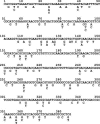Multilocus sequence typing scheme that provides both species and strain differentiation for the Burkholderia cepacia complex
- PMID: 16145124
- PMCID: PMC1234123
- DOI: 10.1128/JCM.43.9.4665-4673.2005
Multilocus sequence typing scheme that provides both species and strain differentiation for the Burkholderia cepacia complex
Abstract
A single multilocus sequence typing (MLST) scheme was developed for precise characterization of the opportunistic pathogens of Burkholderia cepacia complex (BCC), a group composed of at least nine closely related species. Seven conserved housekeeping genes were selected after a comparison of five Burkholderia species, and a collection of strains was subjected to nucleotide sequence analysis using a nested PCR amplification approach for each gene. MLST differentiated all nine current BCC species and identified 114 sequence types within a collection of 119 strains. No differentiation was found between strains recovered from environmental or clinical sources. The improved resolution in strain identification offered by MLST was able to identify previously characterized epidemic strain lineages and also demonstrated the presence of four novel potential species groups within the complex. There was also evidence for recombination having an important role in the recent evolution of individual BCC species. This highly transferable, validated, MLST scheme provides a new means to assist in species identification as well as unambiguous strain discrimination of the BCC by a single approach. It is also the first MLST scheme designed at the outset to incorporate multiple species and should facilitate global epidemiological investigations of the BCC.
Figures


References
-
- Aaron, S. D., W. Ferris, D. A. Henry, D. P. Speert, and N. E. Macdonald. 2000. Multiple combination bactericidal antibiotic testing for patients with cystic fibrosis infected with Burkholderia cepacia. Am. J. Respir. Crit. Care Med. 161:1206-1212. - PubMed
-
- Coenye, T., E. Mahenthiralingam, D. Henry, J. J. LiPuma, S. Laevens, M. Gillis, D. P. Speert, and P. Vandamme. 2001. Burkholderia ambifaria sp. nov., a novel member of the Burkholderia cepacia complex including biocontrol and cystic fibrosis-related isolates. Int. J. Syst. Evol. Microbiol. 51:1481-1490. - PubMed
Publication types
MeSH terms
Substances
Grants and funding
LinkOut - more resources
Full Text Sources
Other Literature Sources
Molecular Biology Databases

